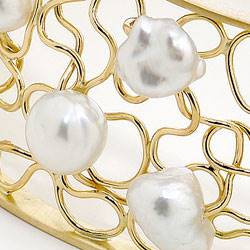|
News
Articles from PEARL JEWELLERY (386 Articles), INDUSTRY ASSOCIATIONS (263 Articles), PEARLS - LOOSE / TEMPORARILY STRUNG (37 Articles)

Keshi pearls
Worldwide pearl alert
Posted May 18, 2010 |
Keshi cultured pearls are being wrongly labelled – and sold – as natural pearls, according to warnings from a worldwide authority on gem gradings.
The Swiss Gemmological Institute (SSEF) issued the alert after receiving large quantities of saltwater pearls labelled as “natural”.
Their near-perfect appearance raised suspicions, and extensive testing later revealed these pearls were actually beadless cultured pearls, also known as “Keshi” pearls.
According to SSEF, the arrival of the incorrectly labelled “natural” pearls represented “a great danger to the natural pearl market”.
Natural pearls command a much higher price than cultured pearls, meaning there is a financial incentive for some traders to incorrectly label their pearls.
SSEF suggested the situation was suspicious.
“We have reliable information that some individuals are purposely selecting those cultured pearls with the most intriguing and potentially confusing internal structures (using radiography) from the large stocks they purchase from pearl farms, so as to later introduce them onto the natural pearl market,” SSEF director Michael Krzemnicki said in a statement.
In response, the SSEF has clarified the definitions of natural and cultured pearls.
“A natural pearl is a pearl which formed in a wild oyster (mussel) and is found in its natural habitat. It formed without any human intervention,” the company stated, adding, “Any pearl stemming from a pearl cultivation farm is a cultured pearl. The SSEF considers that pearl farming constitutes a human intervention.”
According to SSEF, beadless cultured pearls do not have any distinguishing features, although they are typically button, oval, drop-shaped, or baroque. Perfectly round or barrel-shaped beadless cultured pearls are rare. They can be properly identified by radiography.
To protect the natural pearl trade, the SSEF has changed its pearl certification policy.
For single pearls, micro x-ray tomography will be introduced as a testing method in order to provide more accurate reports.
Groups of pearls that include Keshi pearls will be labelled as containing cultured pearls, without distinguishing between natural and cultured.
SSEF concluded by flagging the introduction of a definitive set of standards for the pearl industry.
“The SSEF is working on different levels with international trade organisations and other laboratories on this topic so as to harmonise pearl testing standards now and in future.”
More Reading: Pearls get new guidelines
Learn about: Keshi pearls
New pearl products: Opula | Vina
|
|
|
|